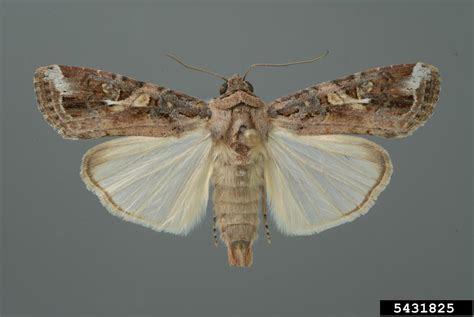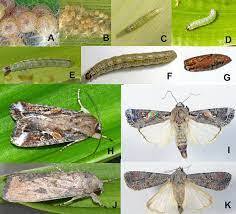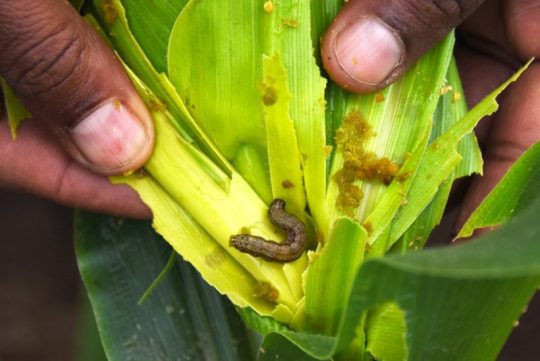#Spodoptera frugiperda
Text
IMPORTANT BUGWORLD NEWS !!

radiation resistant moths :3


(Spodoptera frugiperda/fall armyworm and Helicoverpa armigera/cotton bollworm).
unfortunately for the radiation goblins, these little guys are pests who eat crops. so we've got some neat competition going if the radiation-goblins decide to take up agriculture. i really want to look up chernobyl and such to see what actually settled there but might be a starting point for insect evolution in the radiation-blasted regions
on other wilder bugworld news i think it would be neat if we got a hermit-crab-like creature who basically parasitises the machine army. exploits some weakness to get inside the machines and uses them as a shell
(bugworld is from this post by @skitter-queen and I dumped my nilbog goblin spec evo thoughts here!! please look at my goblins they eat radiation and have ssooooo many genes :] their lore is updated since the first post)
#i also want to start thinking about parts of bugworld other than. the radiation#but radiation... is cool...#bugworld#worm#wormblr#machine army#machine army is actually probably fucking up the radiation plains too... maybe my pacifist radiation goblins are unrealistic
5 notes
·
View notes
Text
Saw this:

Needed to know.
The endocannabinoid system exerts an important neuromodulatory role in mammals. Knockout mice lacking cannabinoid (CB) receptors exhibit significant morbidity. The endocannabinoid system also appears to be phylogenetically ancient--it occurs in mammals, birds, amphibians, fish, sea urchins, leeches, mussels, and even the most primitive animal with a nerve network, the Hydra. The presence of CB receptors, however, has not been examined in terrestrial invertebrates (or any member of the Ecdysozoa). Surprisingly, we found no specific binding of the synthetic CB ligands [(3)H]CP55,940 and [(3)H]SR141716A in a panel of insects: Apis mellifera, Drosophila melanogaster, Gerris marginatus, Spodoptera frugiperda, and Zophobas atratus. A lack of functional CB receptors was confirmed by the inability of tetrahydrocannabinol (THC) and HU210 to activate G-proteins in insect tissues, utilizing a guanosine-5'-O-(3-[(35)]thio)-triphosphate (GTP gamma S) assay. No orthologs of human CB receptors were located in the Drosophila genome, nor did we find orthologs of fatty acid amide hydrolase. This loss of CB receptors appears to be unique in the field of comparative neurobiology. No other known mammalian neuroreceptor is understood to be missing in insects. We hypothesized that CB receptors were lost in insects because of a dearth of ligands; endogenous CB ligands are metabolites of arachidonic acid, and insects produce little or no arachidonic acid or endocannabinoid ligands, such as anandamide.[1]
TLDR: they can't get high as they lack the necessary receptors for it.
3 notes
·
View notes
Text
Team of Global Experts to Develop Beneficial Nematode-based Biocontrol Solution to Fall Armyworm
CABI has joined a team of international experts to develop beneficial nematode-based biocontrol solutions to fight the devastating fall armyworm (Spodoptera frugiperda) in Africa.
Entomopathogenic nematodes are tiny insect-killing worms, also called beneficial nematodes, and have been used for nearly a century as safer-to-use and more environmentally friendly biocontrol agents against insect…

View On WordPress
0 notes
Text
Quelles sont les 5 pires espèces d’insectes invasifs qui menacent l’Europe ? Réponse en vidéo !
See on Scoop.it - EntomoNews
youtube
loadYouTubePlayer('yt_video_l9Qc4LfSHiU_f1wg1ztsJ6ioRFvS');
Aujourd'hui, je te présente mon TOP 5 des espèces d’insectes qu’il faut absolument empêcher d'entrer en Europe
- le scarabée japonais Popillia japonica,
- la légionnaire d’automne Spodoptera frugiperda.
- l’agrile du frêne Agrilus planipennis
- le capricorne asiatique Anoplophora glabripennis
- la mouche orientale des fruits Bactrocera dorsalis
Les 5 PIRES espèces d’insectes invasifs pour l’Europe
Science bestiale, 3 mars 2024
"Je m'appelle François Verheggen, je suis professeur d'entomologie et j'évalue régulièrement les risques posés par les espèces exotiques envahissantes.
Dans cette vidéo, je vais te parler d’espèces invasives. Ce sont ces êtres vivants qui sont introduits et qui s’installent dans un nouvel habitat, et dont la prolifération y provoque des dégâts.
L’Europe a dressé une liste d’espèces prioritaires. Ce sont 20 espèces vivantes, que l’on appelle espèce de quarantaine, car elles sont absentes d’Europe, et dont l'établissement pourrait avoir des conséquences dramatiques."
Santé des végétaux : 20 organismes de quarantaine dans l'UE https://ec.europa.eu/commission/presscorner/detail/fr/IP_19_5981
-------
NDÉ
via François Verheggen sur LinkedIn, 03.03.2024
0 notes
Text
Agroecological solutions better than pesticides in fighting fall armyworm, experts say
Fall armyworm (Spodoptera frugiperda) is an invasive agricultural pest, which first hit West Africa in 2016 and quickly spread across the continent.
Experts have now found that the pest’s impact on maize yields is no longer as severe as initially feared.
An integrated pest management approach, prioritizing nontoxic control measures, is the best way to tackle the infestation, improve yields and…

View On WordPress
0 notes
Text
Βιολογία του φυτοπαράσιτου Spodoptera frugiperda
Τα στάδια ανάπτυξης του εντόμου Spodoptera fugiperda
Το Spodoptera frugiperda είναι έναέντομο παράσιτο γνωστό ως εχθρός καλλιεργειών στην Βόρεια και την Νότια Αμερική και έχει γίνει ένας σημαντικός εχθρός παγκοσμίως από την προηγούμενη δεκαετία. Προσβάλλει ένα ευρύ φάσμα φυτών ξενιστών και λόγω της ραγδαίας εξάπλωσής του είναι αρκετά δύσκολο να αντιμετωπιστεί. Στην χώρα μας το έντομο αυτό έχει…

View On WordPress
0 notes
Text
Transcriptomics and interactomics during the primary infection of an SfNPV baculovirus on Spodoptera frugiperda larvae
Pubmed: http://dlvr.it/T05K1s
0 notes
Link
0 notes
Text
Application of cell culture flasks in culturing Sf9 cells
Sf9 cells are Spodoptera frugiperda cells, which are usually used to produce various medicinal proteins and viruses, or for basic research. When culturing sf9 cells, the commonly used cell culture consumables are cell culture flasks.
Sf9 cells are derived from the Insect Pathology Laboratory of the United States Department of Agriculture and are derived from the IPLBSF-21 cell line. The cells are regular with particles and can be cultured in suspension or adherent culture. This cell has a high expression level (especially intracellular proteins), has a faster growth rate, effective protein folding, glycosylation is similar to mammalian cells, and relatively easy enzymatic deglycosylation (for protein structure determination) Favorable), is widely used in the expression of V LPs.

0 notes
Link
1 note
·
View note
Text
MAMESTRA BRASSICAE NPV
MbNPV (MAMESTRA BRASSICAE NPV) has a relatively broad spectrum and can infect more than 30 kinds of Lepidoptera insects. MbNPV can be used to develop broad-spectrum viral insecticides.
MbNPV can control pests such as Spodoptera frugiperda, diamondback moth, cotton bollworm, corn borer, rice leaf roller, tea geometrid, tobacco budworm and cutworm. When 2 billion PIB/mL MbNPV SC 750mL/hm2 was…
View On WordPress
0 notes
Text
Quantitative Effects of Temperature and Exposure Duration on the Occurrence and Repair of Indirect Chilling Injury in the Fall Armyworm Spodoptera frugiperda
http://dlvr.it/SnG27k
0 notes
Text
India: New Project Supported By The UK With CHAP, Knowmatics, Ystumtec and CABU To Help Implement Monitoring Tools
An international project addressing invasive pests has received further funding to help implement monitoring tools for smallholders in India. For example, the fall armyworm, Spodoptera frugiperda, is known to cause significant damage to crops worldwide. The UK Government provided initial funding through the Foreign, Commonwealth & Development Office (FCDO)’s Science and Innovation Network in…

View On WordPress
0 notes
Text
CABI empowers farmers in Kenya on a cost-efficient, sustainable, and promising alternative for fall armyworm management
Researchers from CABI’s regional centre for Africa organised a farmer’s field event in Machakos County, Kenya, providing comprehensive training to 582 farmers regarding the production of baculorvirus-based insecticides for managing the fall armyworm (Spodoptera frugiperda).
The team also conducted assessments to gauge the farmers’ proficiency in fall armyworm management through biopesticides,…

View On WordPress
0 notes
Link
Safer-to-use and more environmentally-friendly biopesticides should be preferred to fight the fall armyworm (Spodoptera frugiperda) pest instead of more harmful chemical pesticides, a new CABI-led study published in the Journal of Pest Science suggests. CABI scientists teamed up with colleagues from Ghana’s CSIR-Savanna Agricultural Research Institute (SARI), the University for Development Studies (UDS) and the Plant Protection and Regulatory Services Directorate (PPRSD) to investigate the effects of insecticides – including biopesticides – on the environment.
0 notes